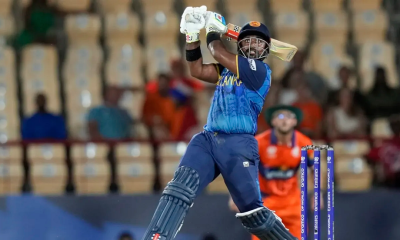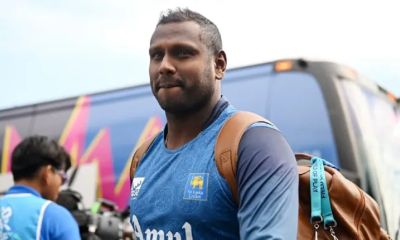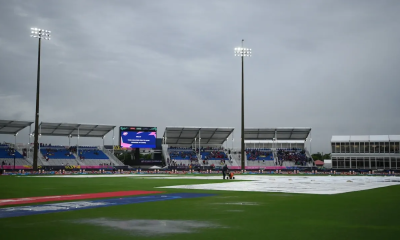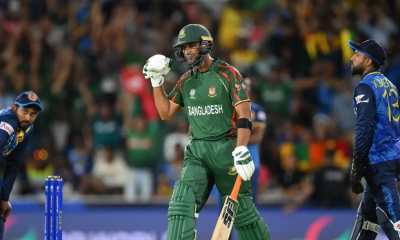News
Dengue situation becoming as bad as record outbreak in 2017

By Rathindra Kuruwita
The current statistical trends indicate that the number of Sri Lanka’s dengue patients this year can be as high as in 2017 where 186,101 cases were reported, Dr. Dinu Guruge, Consultant for Dengue Global Programme – Drugs for Neglected Diseases initiative (DNDi) and Regional Epidemiologist at Colombo Municipal Council (CMC) said during an event organised by the International Society for Neglected Tropical Diseases recently.
The highest number of dengue cases in Sri Lanka was reported in 2017.
“In 2017, there were about 300 dengue cases a week in the CMC area. Right now, the number of cases we see in 2023 is only second to what we saw in 2017. Which means we have to look forward to an outbreak close to 2017 and Sri Lankan medical officers are working to prevent that from happening. Those at the CMC have been dealing with this kind of situation for the last decade,” she said.
Dr. Guruge added that the CMC spent as much as 10 percent of its annual health budget on chemicals used for dengue control. Another 25 percent of the budget was spent on other dengue-related activities.
“This is hue. About 35 percent of the CMC health budget is spent on dengue-related activities,” she said.
The Regional Epidemiologist at the CMC also said that the actual number of dengue cases could be three times that of reported cases.
Dr. Jagath Amarasekera, Public Health Specialist, National Dengue Control Unit, Ministry of Health, said that Sri Lanka serologically confirmed dengue in 1962 and that dengue fever was made a notifiable disease in 1996.
From 1990 to around 2008 there were about 4000 to 10,000 cases of dengue a year.
“In 2009, we saw an outbreak where we recorded 35,095 cases. Then we saw about 35,000 to 50,000 cases a year until about 2016, and in 2017, we saw 186,101 cases. There were 105, 049 cases in 2019. We had 76,689 cases in 2022. After 2009, there is more awareness of dengue, patients identified the symptoms and doctors were actively looking for cases. So, they also contributed to increasing the numbers,” he said.
Dr. Amarasekera added that in the first 20 weeks of 2022, there were 9837 cases in the Western Province, this year the number is 17,715, which is about 49.6 percent of cases. The Eastern province accounts for 12.2 percent and the Northwestern province accounts for 10.3 percent, of the cases.
“If you can control dengue in the Western province, it can have a big impact. We usually have two periods, following the monsoons, where cases spike, but the baseline is relatively low. However, this year the baseline, too, has been high – this can especially be seen in the Gampaha District. This high baseline is what worries us. An outbreak on top of a high baseline could mean trouble. We are doing a lot to prevent this,” he said.
Dr. Amarasekera said on average its men who mainly contract dengue, about 57 percent. Among the cases, about 62 percent belong to the working population. Given that these are often breadwinners of the family, there is delayed medical attention seeking behaviour among the working population and that causes complications.
“One of the objectives of the national dengue prevention and control campaign is to reduce the prevalence below 100 out of 100,000 Sri Lankans. So basically to keep the cases below 22,000 as we have about 22 million people. Our other objective is to reduce and maintain the case fatality rate below 0.1 percent by 2023, or one death for 1000 cases,” he said.
Dr. Amarasekera said that in 2009, about one percent of those with dengue died. The number of cases have exploded since then and if that rate persisted hundreds of people would be dying each year, he said.
“You can see the magnitude of the problem when you have about 35 000 cases. One percent case fatality means about 350 deaths. But ever since 2008, due to improved clinical guidelines, capacity building, the logistics for treatment, etc., improved. So, the fatality rate has been dropping since. Even last year it was less than 0.1 percent,” he said.
There are two types of dengue vectors, i.e. Aedes aegypti and Aedes albopictus. The primary vector is Aedes aegypti and when one looks at their breeding sites in 2023, about 28 percent of these sites are discarded items (mainly plastic items thrown away), 23 percent are water storage items, 11 percent in ornamental items and ponds, nine percent in temporary removed items (i.e. items that people take out of the house to dispose but they never do), eight percent in tyres, six percent in covering items, and five percent in other items, he said.
Prof. Neelika Malavige, Head of the Department of Immunology and Molecular Medicine, University of Sri Jayewardenepura, and the Head of Dengue Global Programme at DNDi, said that the global impact of dengue has been increasing rapidly in the past few decades. Global infections increased from 23 million in 1990 to 104 million in 2017, she said, adding that dengue is a climate sensitive infection, and that climate change, rapid urbanization, and population expansion are making things worse.
“There is also a massive economic cost of dengue. Global cost of dengue was estimated, in 2014, at eight billion U.S. dollars but this is a gross underestimation. The cost for India alone in 2016 was 5.71 billion U.S. dollars,” he said.
She added that DENV3 is the dominant serotype in Sri Lanka now. While the country has experienced this serotype, but it was not predominant in here for some time. When a serotype emerges after a few years, there are a significant number of people who are not immune.
“When a serotype is reintroduced after about 10-15 years, then you have massive outbreaks. Although dengue cases have been increasing over time, in all age groups, the increase is disproportionately high in older age groups. In 2000, close to 60 percent (59.9) patients were those under 19, in 2018 those under 19 accounted for only 35.7 percent of reported cases. More infections in adults means more infections among pregnant women, those over 65 and those with comorbidities. This poses more challenges,” Prof. Malavige said.
She added that the main public health measure to counter dengue in Sri Lanka has been vector control, a strategy most countries follow. However, most people in dengue control realize vector control alone isn’t enough. Much more needs to be done to come up with a treatment for the disease.
There is no specific treatment for dengue and the focus is on treating pain symptoms.
“In the CMC area, by the age of 20, about 97 percent of people are seropositive. In Colombo and semi urban areas the number is at 80 percent. This means that they have had dengue by the age of 20. However, seroprevalence is much lower in other districts. Dengue is a big problem in the Western Province,” she said.
Prof. Malavige said that a vaccine against dengue has been touted as a silver bullet. However, countries have to think about the efficacy rate of a vaccine for those who have not been exposed to dengue.
“We have a new vaccine coming up, by Takeda, and several countries have registered it. The European Medical Agency gave approval to the vaccine. Based on the published data the cumulative efficacy of the vaccine after three years was 62 percent against virologically confirmed dengue (VCD) and 83.6 percent against hospitalized VCD. These are for seropositive individuals. However, for seronegative individuals, against dengue 03, efficacy is quite low,” she said.
Prof. Malavige said despite the massive costs of dengue for developing nations, there are many who ask if there is a need for a treatment for dengue. There are many who believe that a vaccine could address the problems caused by dengue.
“This shows the neglected nature of dengue. People do not understand the burden of dengue because it does not affect high income countries usually. We do need treatment to ensure that cases do not get serious,” she said.
Prof. Malavige said DNDi has put together a dengue alliance, which includes Mahidol University, Thailand, Translational Health Science and Technology Institute, India, Institute for Medical Research, Malaysia. Oswaldo Cruz Foundation (Fiocruz), Brazil, DNDI and The Federal University of Minas Gerais, Brazil, to find a treatment for dengue.
“Initial strategy is to repurpose drugs, because we know the safety of drugs and can rapidly deploy them for clinical drugs. The preclinical working group is working on in vitro testing for antivirals, host directed therapies and in vivo testing on mouse models. We all need to collaborate and this is the magic word,” she said.
News
NPP wins most LG bodies but sees drop in vote share: Hung councils raise concern

SJB trying to take control of CMC
Govt. suffers set back in N&E
SLPP records significant increase in votes but fails to win single body
The ruling National People’s Power (NPP) secured 266 out of 339 local government bodies at the May 6 election but suffered a setback in the northern and eastern regions as the Illankai Thamil Arasu Kadchi (ITAK) and the Sri Lanka Muslim Congress (SLMC) won 42 local authorities.
The ITAK and SLMC secured 37 and 05 local government bodies, respectively, although President Anura Kumara Dissanayake personally led the NPP’s campaign in the former war zone. The National Congress won the Akkaraipattu MC. In the last parliamentary election held in Nov. 2014, the NPP won all electoral districts, except Batticaloa.
The NPP obtained 4,503,930 votes countrywide whereas in the last parliamentary election it received 6,863,186 votes; there has been a drop of 2,359,256 votes.
The Samagi Jana Balawegaya (SJB) won 13 local government bodies, but the United National Party (UNP) and the Sri Lanka Podujana Peramuna (SLPP) failed to secure any.
The SLPP obtained 954,517 votes and 742 seats, accounting for 9.17% of the national vote. In a post on X, SLPP’s National Organiser Namal Rajapaksa said: “Over the past six months, the SLPP has regrouped and gained momentum by staying true to our principles. While some rely on false promises, we remain committed to honest, principled politics that put the people first. Thank you to everyone who stood by us. This is just the beginning. We will keep working, village by village, to rebuild and restore trust in real leadership.” The SLPP polled only 350,429 votes in last year’s general election.
In the 2018 LG polls, the SLPP won 231 councils. That was the first time the government of the day failed to win mini polls. Yahapalana partners, UNP and SLFP, having contested separately, suffered a debilitating setback.
In spite of the massive campaign carried out by the NPP, targeting the Colombo Municipal Council (CMC), the ruling party failed to secure an overall majority there. The NPP polled 81,000 votes to obtain 48 seats whereas the SJB and UNP polled 58,375 (29 seats) and 26,297 (13 seats) votes, respectively. The SLPP (05), SLMC (04), United Republican Front (01), United Peace Alliance (02), Sarvajana Balaya (02), and National People’s Party, National Freedom Front, People’s
Alliance and Democratic National Alliance one each.
In addition to political parties, five Independent Groups shared the remaining 09 seats of the CMC.
With no party holding a clear majority, the next Colombo Mayor will need to be elected through a Council vote.
SJB General Secretary Ranjith Madduma Bandara told a hastily arranged media conference that the SJB intended to elect an SJBer as Colombo Mayor with the help of the other Opposition parties. The former Minister said that the SJB would cooperate with the other parties in the Opposition regarding the appointment of Mayors and Chairmen of the hung local councils.
Meanwhile, the Leader of the House, Bimal Ratnayake, has said those who won local government bodies in the Northern Province but without absolute majorities have sought NPP support to form administrations.
Addressing a separate media briefing, JVP General Secretary, Tilvin Silva, declared that the ruling party wouldn’t, under any circumstances, form coalitions with those who had been rejected by the people.
News
Local councils won by political parties and Ind. groups

Colombo District
NPP:
Colombo MC, Dehiwala-Mount Lavinia MC, Sri Jayewardenepura MC, Moratuwa MC, Kaduwela MC, Kolonnawa UC, Seethawakapura UC, Maharagama UC, Kesbewa UC, Boralesgamuwa UC, Kotikawatte PS, Seethawaka PS and Homagama PS.
Gampaha District
NPP:
Negombo MC. Gampaha MC, Wattala-Mabola UC (both NPP and SJB obtained six seats each), Katunayaka-Seeduwa UC, Minuwangoda UC, Ja-ela UC, Peliyagoda UC, Wattala PS, Katana PS, Divulapitiya PS, Mirigama PS, Minuwangoda PS, Attanagalle PS, Gampaha PS, Mahara PS, Dompe PS, Biyagama PS and Kelaniya PS.
Kalutara District
NPP:
Panadura UC, Horana UC, Kalutara MC, Panadura PS, Bandaragama PS, Horana PS, Madurawala PS, Bulathsinhala PS, Matugama PS, Dodangoda PS, Kalutara PS, Beruwala PS, Agalawatta PS (both NPP and SJB obtained six seats each), Millaniya PS and Walallawita PS
Kandy District
NPP:
Kandy MC, Wattegama UC, Kadugannawa UC, Nawalapitiya UC, Thumpane PS, Harispattuwa PS, Poojapitiya PS, Pathadumbara PS, Udadumbara PS (both NPP and SJB obtained six seats each), Minipe PS, Medadumbara PS, Kundasale PS, Pathahewaheta PS, Kandy Four Gravets and Gangawatta Korale PS, Yatinuwara PS, Udunuwara PS, Udapalatha PS, Ganga Ihala Korale PS and Pasbage Korale PS.
Matale District
NPP:
Dambulla MC, Matale MC, Pallepola PS, Galewela PS, Dambulla PS, Naula PS, Laggala-Pallegama PS (both NPP and SJB obtained six seats each), Wilgamuwa PS, Matale PS, Yatawatta PS, Ukuwela PS, Rattota PS.
Nuwara Eliya District
NPP
Nuwara Eliya MC, Hatton-Dikoya UC, Thalawakale-Lindula UC, Maskeliya PS, Norwood PS (NPP and Ceylon Workers’ Congress ‘P’ wing won six seats each), Ambagamuwa PS, Agarapathana PS (NPP and Ceylon Workers’ Congress ‘P’ wing won four seats each), Kotagala PS ((NPP and Ceylon Workers’ Congress ‘P’ wing won five seats each), Nuwara Eliya PS, Kothmale PS, Hanguranketha PS and Walapone PS.
Galle District
NPP:
Galle MC, Ambalangoda UC, Hikkaduwa UC, Balapitiya PS, Ambalangoda PS, Welivitiya Divithura PS, Karandeniya PS, Bentota PS, Neluwa PS, Thawalama PS, Nagoda PS, Niyagama PS, Baddegama PS, Yakkalamulla PS, Rajagama PS, Akmeemana PS, Bope Poddala PS, Imaduwa PS and Habaraduwa PS.
Matara District
NPP:
Matara MC, Weligama UC, Pitabeddara PS, Kotapola PS, Kirinda Puhulwella PS, Mulatiyana PS, Pasgoda PS, Athureliya PS, Akuressa PS, Malimbada PS, Hakmana PS, Kamburupitiya PS, Thihagoda PS, Devinuwara PS, Dikwella PS, Matara PS and Weligama PS.
Hambantota District
NPP:
Hambantota MC, Tangalle UC, Weeraketiya PS, Katuwana PS, Beliatta PS, Tangalle PS, Angunakolapelessa PS, Ambalantota PS, Tissamaharama PS, Sooriyawewa PS, Hambantota PS and Lunugamwehera PS.
Jaffna District
ITAK:
Jaffna MC, Chavakachcheri UC (ITAK and ACTC won six seats each), Delft PS, Velanai PS, Walikamam west PS, Walikamam north PS, Walikamam south-west PS, Walikamam south PS, Walikamam east PS, Vadamaratchchy South West PS, PPD PS, Chavakachcheri PS and Nallur PS.
ACTC
VVT UC, PPD UC, Karainagar PS ( ACTC, UNP, NPP , TMK and Ind group ii won two seats each), Kayts PS (EPDP),
Kilinochchi District
ITAK:
Pachchilaippalli PS, Karachchi PS and Poonakary PS
Mannar District
ITAK:
Mannar UC, Mannar PS, Manthai West
NPP:
Nanattan PS
SJB:
Musali PS
Vavuniya District
Vavuniya MC (DTNA, NPP and Sri Lanka Labour Party won four seats each)
NPP:
Vavuniya north PS, Vavuniya south (Tamil) PS and Vavuniya South (Sinhala) PS
SJB:
Vengalasettikulam PS
Mullaitivu District
ITAK:
Manthai East PS, Thunukai PS
ITAK:
Puthukudirippu PS and Maritimepattu PS
SJB:
Kalutara District
Palindanuwara PS
Kandy district
SJB:
Gampola UC
Akurana PS
Panwila PS
Matale
Ambanganga Korale PS
Kalutara District
Ind. Group 1 Beruwela UC
Batticaloa district
ITAK:
Batticaloa MC, Eravurpattu PS, Koralaipattu PS, Manmunai South and Eluvil Pattu, Manmunai Pattu PS, Manmunai West and Porathivu Pattu PS.
SLMC:
Eravur UC, Kathankudi UC,
TMVP:
Koralai Pattu North, Manmunai South West PS (ITAK and TMVP won six seats each)
Ampara district
National Congress:
Akkaraipattu MC, Akkaraipattu PS
NPP:
Ampara UC, Dehiattakandiya PS, Damana PS, Uhana PS, Mahaoya PS, Namaloya PS, Padiyatalawa PS, Lahugala PS,
ITAK:
Navithanveli PS, Alayadiwembu (ITAK and NPP won seven seats each), Karaitheevu PS
ACMC:
Sammanthurai PS, Ninthavur PS
SLMC:
Irakkamam PS, Addalachenai PS,
Independent Group 4
Pottuvil PS
Independent Group 1
Thirukkovil PS
Trincomalee District
ITAK:
Trincomalee MC, Verugal PS, Trincomalee town and Gravets PS, Muttur PS,
ACMC:
Kinniya UC (SJB and ACMC won four seats each) and Kinniya PS
NPP:
Seruwila PS, Kantale PS, Morawewa PS, Gomarankadawela PS, Padavisripura PS, Thambalagamuwa PS (NPP and SJB won three seats each)
SLMC:
Kuchchuveli PS,
Kurunegala District
NPP:
Kurunegala MC, Kuliyapitiya UC, Giribawa PS, Galgamuwa PS, Polpithigama PS, Nikaweratiya PS, Kobeigane PS, Mahawewa PS, Ibbagamuwa PS, Wariyapola PS,Panduwasnuwara PS, Bingiriya PS, Udubaddawa PS, Pannala PS, Kuliyapitiya PS, Alawwa PS, Narammala PS, Polgahawela PS, Kurunegala PS, Mawathagama PS and Rideegama PS.
Puttalam District
NPP:
Puttalam MC, Chilaw UC, Kalpitiya PS (NPP and SJB won 10 seats each), Puttalam PS, Wanathawilluwa PS, Karuwalagaswewa PS,Nawagaththegama PS, Anamaduwa PS, Arachchikattuwa PS, Chilaw PS, Nattandiya PS and Wennappuwa PS.
Anuradhapura District
NPP:
Anuradhapura MC, Medawachchiya PS, Rambawewa PS, Kebitigollewa PS, Padaviya, Kahatagasdigiliya PS, Horowpothana PS, Galenbindunuwewa PS, Thalawa PS, Nuwaragampalatha Central PS, Nuwaragampalatha east PS, Nochchiyagama PS, Rajanganaya PS, Galnewa PS, Ipologama PA, Mihintale PS, Thirappane PS, Kekirawa PS and Palagala PS.
Polonnaruwa District
NPP:
Polonnaruwa MC. Elahera PS, Hingurakgoda PS, Medirigiriya PS, Lankapura PS, Welikanda PS, Dimbulagala PS and Polonnaruwa PS.
Badulla District
NPP:
Badulla MC, Bandarawela MC, Mahiyanganaya PS, Ridimaliyadde PS, Soranthota PS,Meegahakivula PS, Kankaketiya PS, Passara PS, Lunugala PS, Badulla PS, Hali ela PS, Uva Paranagama PS, Welimada PS, Bandarawela PS, Ellpa PS,Haputale PS and Haldamulla PS.
Independent Group:
Haputale UC
Moneragala District
NPP:
Bibile PS, Medagama PS, Madulla PS, Siyambalanduwa PS, Monaragala PS, Badalkumbura PS, Buttala PS, Kataragama PS, Wellawaya PS and Thanamalwila PS
NPP also won all LG authorities in Ratnapura and Kegalle districts.
News
15 more Sri Lankan youth rescued from cybercrime camps in Myanmar

Fifteen Lankans, forcibly held in cybercrime camps in Myanmar, had been rescued on Tuesday (06), government sources said.
This operation was carried out through coordination between the Sri Lankan Ministries of Foreign Affairs, Foreign Employment, and Tourism, along with the Sri Lankan Embassy in Thailand and the Thai government.
The rescued Sri Lankan youth were handed over to the Sri Lankan Ambassador in Thailand, Wijayanthi Edirisinghe, by Thai authorities on Tuesday morning in Mae Sot, located in the Myawaddy region, along the Myanmar-Thailand border. Officials from the Thai Embassy also attended the handover.
This rescue was the result of diplomatic efforts and telephone discussions held by Sri Lanka’s Minister of Foreign Affairs, Foreign Employment and Tourism, Vijitha Herath, with Thailand’s Minister of Foreign Affairs, Maris Sangiampongsa, and Myanmar’s Minister of Foreign Affairs, U Than Swe.
The rescue operation was supported diplomatically by the Thai Embassy, the International Organisation for Migration (which provided transportation), non-governmental organisations offering welfare assistance, and officials of the Thai and Myanmar governments.
Minister Vijitha Herath expressed appreciation for their roles.
Previously, 14 Sri Lankans were rescued from cybercrime camps in Myanmar on March 18, and 27 others were brought back to Sri Lanka on Dec. 17, 2024.
By Shyam Nuwan Ganewatte
-

 News6 days ago
News6 days agoRanil’s Chief Security Officer transferred to KKS
-

 Opinion4 days ago
Opinion4 days agoRemembering Dr. Samuel Mathew: A Heart that Healed Countless Lives
-

 Business2 days ago
Business2 days agoAitken Spence Travels continues its leadership as the only Travelife-Certified DMC in Sri Lanka
-

 Business2 days ago
Business2 days agoLinearSix and InsureMO® expand partnership
-

 Business6 days ago
Business6 days agoCCPI in April 2025 signals a further easing of deflationary conditions
-

 Latest News23 hours ago
Latest News23 hours agoNPP win Maharagama Urban Council
-

 Features6 days ago
Features6 days agoExpensive to die; worship fervour eclipses piety
-

 Latest News4 days ago
Latest News4 days agoThe Heat index is likely to increase up to ‘Caution level’ at some places in Eastern, Northern, North-central and North-western provinces and in Monaragala and Hambantota districts.
























